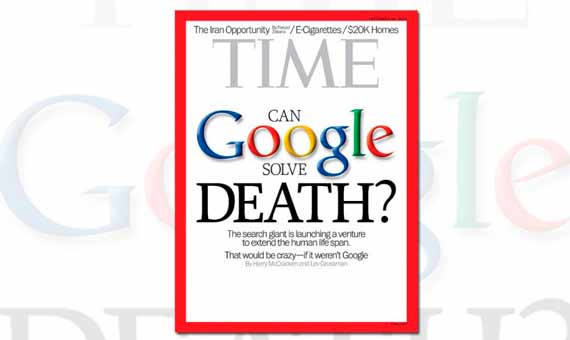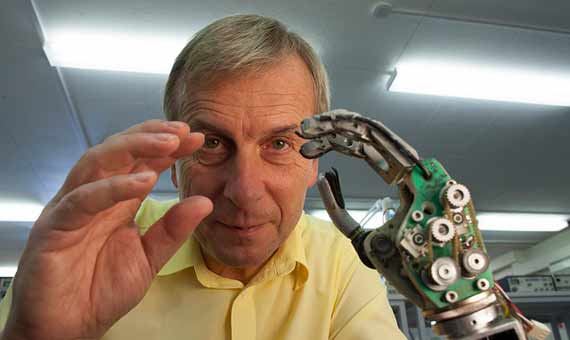Software that predicts market movements better than any analyst; devices capable of diagnosing diseases with an accuracy never seen before; machines that draw paintings that are exhibited in museums and sold in art galleries; programs capable of composing sonatas where it is impossible to discern whether the music was made by a human being or a machine. There are many examples that indicate that the change is already among us, rather than on its way.
Nonetheless, no matter how far the symbiotic love affair between technology and human beings has advanced, the greatest inventions and discoveries are yet to come. This is always the case and history will not let us down this time, either.
In what appeared to be a slogan taken from a work of science fiction, in 2013 Time magazine presented the Calico project with the heading: Can Google solve death?”
This futuristic depiction was the first step taken by the leaders of the large technological firms in Silicon Valley like Larry Page, the founder of Google, Peter Thiel, founder of Pay-Pal, or Mark Zuckerberg, among others, for what they have had in mind for years. It wasn’t so much about whether the largest search engine in the world became a part of the Alphabet consortium last August, or whether our information on Facebook or WhatsApp is part of the assets belonging to Zuckerberg. It is about finding the solution to the largest problem we face, which is the fact that we die and solving it once and for all
Calico or the search for immortality

This project, in which both Google and Apple are involved, was the reason why Time dared to use that heading, the eccentricity of which caused so much controversy. Calico’s primary goal is to develop technologies that combat aging and its associated diseases, such as alzheimer’s, cancer or heart failure.
This attempt to prolong life involves searching for one of the greatest treasures sought for by man throughout history, the image of immortality found in Genesis of Methuselah, who died at the age of 969.
Neil Harbisson, the first cyborg known to “listen to colors”

Harbisson is the personification of synesthesia, and the first recognized cyborg in history. Neil can listen to what others can only see: colors. The work by Kandinsky, “Concerning the spiritual in art” is well known. Here he defines synesthesia and speaks of his first synesthetic experience: “The violins, the deep tones of the bass and especially the wind instruments personified for me all the strength of the twilight hours. I saw all my colors in my mind, right in front of my eyes. Wild, almost crazy lines were sketched in front of me (Kandinsky, 1913/ed. 1982, page 364).
Real, palpable synesthesia that allows the first cyborg officially recognized by a government to live beyond black and white. He has a congenital, non-progressive disease called achromatopsia, or color-blindness, and has made history as the first man-machine since 2004, when he underwent an “eyeborg” implant. This bionic eye, also called “antenna” and metaphorically “third eye”, is osseointegrated in his skull and exits through his occipital bone.
Among other functions, this revolutionary technique allows him to hear frequencies from the light spectrum, which includes colors that are invisible to the human eye, such as infrared and ultraviolet colors. The chip is connected to the Internet, so it can also answer phone calls.
They pay more attention to him than to celebrities and his clothes have to “sound good”, rather than match. Harbisson remembers how difficult it was to face reality, as he has often said: “it was very hard for me to go outside with the antenna, people laugh at you, it has been non-stop since that first summer day. I had to learn to ignore it. I began to feel colors and stopped feeling ridiculous”.
Before becoming a cyborg in the strict sense of the word, while he was in secondary school, he wore an antenna on his head and a 3-pound computer fixed to his chest, created by the technological expert Adam Montandon and himself. The fusion of technology and human nature had not yet occurred in his organism. Harbisson says that he felt drawn between two worlds at the time, but not any more.
In his case, Google Glass expands his knowledge, but not his perception. “What do I care if you tell me something is blue? I want to feel it!”.
Kevin Warwick: the first human being with cybernetic implants

Since the launch in 2013 of the book “There’s a future: Visions for a Better World”, in which Kevin Warwick participate with an article on artificial intelligence and cybernetics, the cybernetics professor at the University of Reading has not stopped making news. Warwick is not solely dedicated to research, but has also played the role of a “guinea pig” more than once.
He is the first human being known the world over to experiment with cybernetic implants in his own body.
The first time he experimented being a man-machine was in 1998, when he underwent an implant in his forearm of a transmitter connected to a computer for nine days that informed of his location. The second attempt of fusion with technology was with a chip implanted in his wrist. With this chip, he was able to move a robotic hand in England from the University of New York, using the signals emitted by his brain.
The third study was conducted in 2002, with the help of his wife; this involved both of them using chips to achieve telepathic communication with each other. In specific terms, they both linked their nervous system to the Internet. His wife, Irina, moved her hand three times and Warwick was able to perceive that movement remotely.
This experiment proved that information could be sent between two nervous systems, as is already occurring in quadriplegic patients whose nervous system has been stimulated using this type of technology. The next step being worked on currently is transferring information from one brain to another.
However, of the three experiments, the last one is the riskiest and the researcher always mentions the ethical problems involved in his experiments. He also asks himself the same question time after time: where is the limit?
The liquid component in the human condition
Change appears to be present in all the dimensions and structures that we live in and with. This is the core idea of the Polish sociologist and philosopher Zygmunt Bauman, when he speaks of his primary thesis on “Liquid Modernity”. According to the author, we live in an age characterized by temporariness, deregulation, liberalization, the precariousness of human bonds and the volatile and short-lasting nature of relationships.
This “liquidity” not only affects the structures that accompany us and that, although near collapse, continue to slide from one side to the other in search of equilibrium. If we contemplate the transhumanist idea that the idea of evolving is part of human beings and of eternal improvement in the best of cases, and also taking into account the reductionist theory that, in the end, human beings are “a network of nerve connections”, we can conclude that human nature can be altered by altering the human brain and thereby moving from the human to the post-human, but not only in a laboratory. In the end, what defines us as human beings would be our capacity to adjust and adapt.
The matter is open to debate
Like a hand that touches everything, the Internet is increasingly a part of our lives. What we still do not know is how it will become a part of our bodies, which has occurred a few times already. Scientists, engineers, philosophers and anyone who is a techno-optimist have no doubt.
The voices and opinions on this matter are reaching the speed of light, such as the statements by the scientific journalist Javier Sampedro, who says that “there are already devices that surpass us in many areas. We still have to see when they will surpass us in talent.” Are intelligent machines a short-term possibility?
Sampedro goes even further: “the progress made in artificial intelligence is so spectacular that it is impossible not to extrapolate them into the future. Like the day we will be able to search in Google by simply thinking about it or we have Wikipedia included in a chip that we can access instantaneously to contrast our lazy memory; the day that our flesh and nerve-based intelligence is multiplied by a thousand thanks to a nerve network attached to our frontal lobe. In sum, a day on which all knowledge, emotions and living experience of the individual can be downloaded from the cloud and we have therefore invented the immortal soul. When machines surpass us in talent, tell us to go take a hike and conquer the galaxy. Hopefully in that order”.
We don’t know if “God does not play dice”, as Einstein said. This expression, which has become almost a slogan, was used by the relativity theorist to explain two premises that have not yet been completed validated or refuted. Einstein considered that there was no room for chance in space and, as far as we know, there is nothing that travels faster than light. However, even though Einstein has neither been disproved or verified, and given that there is much more pending discovery, encoding and decoding, I will leave the question open: Might transhumanism really play dice?
Comments on this publication